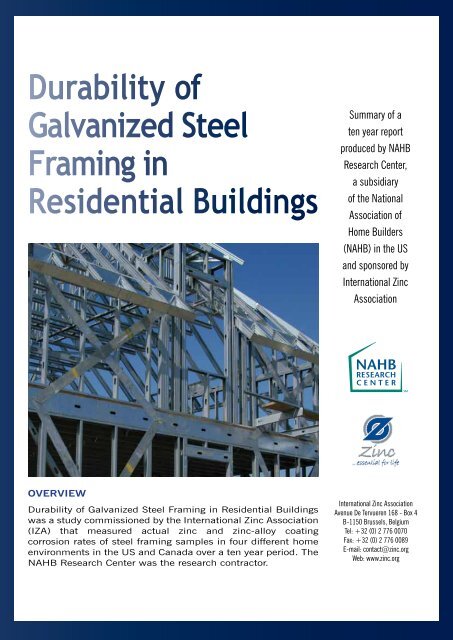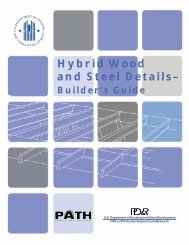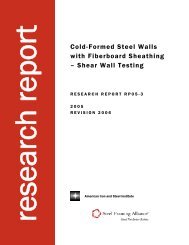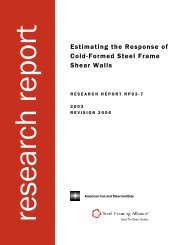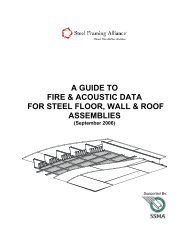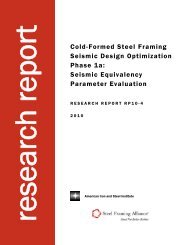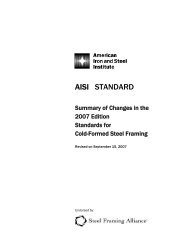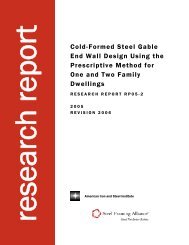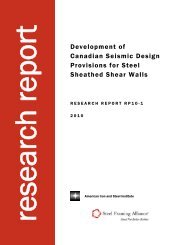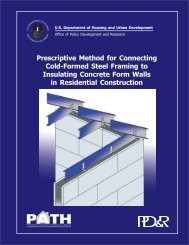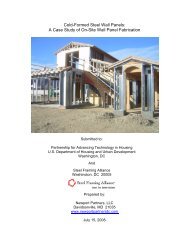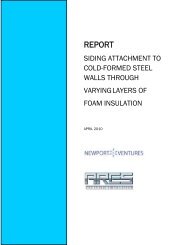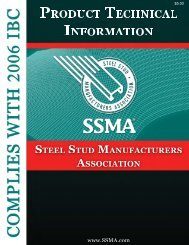Durability of Galvanized Steel Framing in Residential Buildings
Durability of Galvanized Steel Framing in Residential Buildings
Durability of Galvanized Steel Framing in Residential Buildings
You also want an ePaper? Increase the reach of your titles
YUMPU automatically turns print PDFs into web optimized ePapers that Google loves.
<strong>Durability</strong> <strong>of</strong><br />
<strong>Galvanized</strong> <strong>Steel</strong><br />
<strong>Fram<strong>in</strong>g</strong> <strong>in</strong><br />
<strong>Residential</strong> Build<strong>in</strong>gs<br />
OVERVIEW<br />
<strong>Durability</strong> <strong>of</strong> <strong>Galvanized</strong> <strong>Steel</strong> <strong>Fram<strong>in</strong>g</strong> <strong>in</strong> <strong>Residential</strong> Build<strong>in</strong>gs<br />
was a study commissioned by the International Z<strong>in</strong>c Association<br />
(IZA) that measured actual z<strong>in</strong>c and z<strong>in</strong>c-alloy coat<strong>in</strong>g<br />
corrosion rates <strong>of</strong> steel fram<strong>in</strong>g samples <strong>in</strong> four different home<br />
environments <strong>in</strong> the US and Canada over a ten year period. The<br />
NAHB Research Center was the research contractor.<br />
Summary <strong>of</strong> a<br />
ten year report<br />
produced by NAHB<br />
Research Center,<br />
a subsidiary<br />
<strong>of</strong> the National<br />
Association <strong>of</strong><br />
Home Builders<br />
(NAHB) <strong>in</strong> the US<br />
and sponsored by<br />
International Z<strong>in</strong>c<br />
Association<br />
International Z<strong>in</strong>c Association<br />
Avenue De Tervueren 168 - Box 4<br />
B-1150 Brussels, Belgium<br />
Tel: +32 (0) 2 776 0070<br />
Fax: +32 (0) 2 776 0089<br />
E-mail: contact@z<strong>in</strong>c.org<br />
Web: www.z<strong>in</strong>c.org
INTRODUCTION<br />
This summary report is<br />
based on the corrosion<br />
data presented <strong>in</strong> the<br />
NAHB Research Center’s<br />
ten year sample retrieval<br />
report, January, 2009.<br />
The test sites were <strong>in</strong><br />
Miami, Florida; Leonardtown,<br />
Maryland; and Long<br />
Beach Island, New Jersey<br />
<strong>in</strong> the US; and Hamilton,<br />
Ontario <strong>in</strong> Canada. At each<br />
site, numerous test samples<br />
were <strong>in</strong>stalled <strong>in</strong>side<br />
and <strong>in</strong> some cases, outside<br />
<strong>of</strong> the build<strong>in</strong>g (e.g.;<br />
ro<strong>of</strong> trusses, floor systems,<br />
walls, decks).<br />
The ten year coat<strong>in</strong>g loss<br />
measurements from the<br />
four sites have shown<br />
m<strong>in</strong>or mass losses for all<br />
coat<strong>in</strong>g types <strong>in</strong> all sample<br />
colonies (e.g., walls, attics,<br />
floor joists). While calculat<strong>in</strong>g<br />
life expectancies based<br />
on the very low coat<strong>in</strong>g<br />
weight losses found <strong>in</strong><br />
this study is <strong>in</strong>exact, the<br />
measured coat<strong>in</strong>g corrosion<br />
rates extrapolate to<br />
coat<strong>in</strong>g life predictions <strong>of</strong><br />
300 to over 1000 years <strong>in</strong><br />
wall, floor, and ro<strong>of</strong> fram<strong>in</strong>g.<br />
Sample colonies <strong>in</strong>tentionally<br />
located <strong>in</strong> more<br />
aggressive exposures, such<br />
Location Environment Foundation Distance to Water Exterior F<strong>in</strong>ish<br />
Miami, FL<br />
US<br />
Leonardtown, MD<br />
US<br />
Long Beach Island,<br />
NJ US<br />
Hamilton, ON<br />
Canada<br />
as underneath an outdoor<br />
deck and <strong>in</strong> an exposed<br />
crawl space located next<br />
to aggressive tidal waters,<br />
exhibited higher corrosion<br />
rates, but still had a coat<strong>in</strong>g<br />
life greater than 150<br />
years. <strong>Steel</strong> is not recommended<br />
for outdoor use<br />
such as under decks. For<br />
an area near the coast or<br />
other aggressive bodies <strong>of</strong><br />
water, steel <strong>in</strong> a vented or<br />
exposed crawl space would<br />
be specified with a heavier<br />
coat<strong>in</strong>g to significantly<br />
extend its life.<br />
TEST SITES AND<br />
INSTALLATIONS<br />
The four test sites are<br />
described <strong>in</strong> Table 1.<br />
(Additional details are<br />
provided <strong>in</strong> the Appendix.)<br />
Humid, <strong>in</strong>land Slab-on-grade<br />
Semi-mar<strong>in</strong>e with<br />
humid summers<br />
Mar<strong>in</strong>e<br />
Industrial with cold<br />
w<strong>in</strong>ters<br />
TABLE 1 – TEST SITES<br />
Crawlspace<br />
Piers with enclosed<br />
area under house<br />
They represented a range<br />
<strong>of</strong> climates and typical<br />
build<strong>in</strong>g types for each<br />
region. The sites were<br />
chosen such that field<br />
results would be applicable<br />
to a large selection <strong>of</strong> homes<br />
and climates. At each site<br />
numerous test samples<br />
were <strong>in</strong>stalled <strong>in</strong> build<strong>in</strong>g<br />
cavities where steel<br />
fram<strong>in</strong>g would typically<br />
be used (e.g., ro<strong>of</strong> trusses,<br />
floor systems, walls). The<br />
Hamilton and Long Beach<br />
Island sites were also<br />
equipped with electronic<br />
monitor<strong>in</strong>g systems that<br />
measured and recorded<br />
surface temperatures,<br />
relative humidity, and time<br />
<strong>of</strong> wetness dur<strong>in</strong>g the first<br />
year <strong>of</strong> exposure. This data<br />
Several miles from<br />
Atlantic Ocean<br />
Less than 75 feet from<br />
tidal Potomac River<br />
Less than 1/4 mile<br />
from Atlantic Ocean<br />
Stucco<br />
V<strong>in</strong>yl<br />
Alum<strong>in</strong>um<br />
Sid<strong>in</strong>g<br />
Slab-on-grade Inland Brick veneer<br />
was collected to determ<strong>in</strong>e<br />
if thermal and moisture<br />
conditions existed that<br />
would allow condensation<br />
to form on the steel<br />
build<strong>in</strong>g components.<br />
CORROSION SAMPLES<br />
The corrosion samples<br />
consisted <strong>of</strong> z<strong>in</strong>ccoated<br />
(galvanize), 55%<br />
alum<strong>in</strong>um-z<strong>in</strong>c alloycoated<br />
(Galvalume ® ),<br />
and z<strong>in</strong>c-5% alum<strong>in</strong>um<br />
alloy-coated (Galfan ® )<br />
coat<strong>in</strong>gs <strong>in</strong> the form <strong>of</strong><br />
10 cm x 10 cm (3.9 <strong>in</strong>.<br />
x 3.9 <strong>in</strong>.) flat plates and<br />
25 mm (1 <strong>in</strong>.) segments<br />
<strong>of</strong> C-section stud. The flat<br />
plates allowed for a more<br />
def<strong>in</strong>itive determ<strong>in</strong>ation<br />
GALVALUME ® is an <strong>in</strong>ternationally recognized trademark <strong>of</strong><br />
BIEC International Inc., and some <strong>of</strong> its licensed producers.<br />
Galfan ® is a registered trademark <strong>of</strong> the Galfan Technology Center, Inc.
Figure 1 – Plate Samples<br />
<strong>of</strong> the specimen’s area,<br />
and thus a more accurate<br />
measure <strong>of</strong> coat<strong>in</strong>g<br />
corrosion rates calculated<br />
from mass reduction <strong>of</strong><br />
the samples after exposure<br />
(Figure 1). The C-section<br />
samples were <strong>in</strong>stalled<br />
to <strong>in</strong>vestigate corrosion<br />
performance at the edges<br />
and bends <strong>of</strong> a stud. Both<br />
the plate and stud samples<br />
had both sides and all<br />
edges exposed. The coat<strong>in</strong>g<br />
thickness specifications<br />
and measured coat<strong>in</strong>g<br />
weights <strong>of</strong> the samples are<br />
listed <strong>in</strong> Table 2. Coat<strong>in</strong>g<br />
Thickness (column 5) is<br />
the calculated coat<strong>in</strong>g<br />
thickness based on the<br />
measured coat<strong>in</strong>g mass<br />
<strong>in</strong> column 4. Coat<strong>in</strong>g tests<br />
performed per ASTM A90/<br />
A90M 1 determ<strong>in</strong>ed that<br />
actual coat<strong>in</strong>g masses<br />
(column 4) were all above<br />
the m<strong>in</strong>imum specification<br />
requirements. Samples<br />
were <strong>in</strong>stalled to allow for<br />
analysis after one, three,<br />
five, seven, and ten years<br />
<strong>of</strong> exposure. An overview<br />
<strong>of</strong> where samples were<br />
<strong>in</strong>stalled <strong>in</strong> the four sites is<br />
provided <strong>in</strong> Table 3.<br />
Material<br />
RESULTS<br />
Sample retrieval and<br />
corrosion rate calculations<br />
were conducted at one,<br />
three, five, seven, and ten<br />
year <strong>in</strong>tervals. Corrosion<br />
rates were determ<strong>in</strong>ed by<br />
remov<strong>in</strong>g the corrosion<br />
product from the samples<br />
and measur<strong>in</strong>g the<br />
result<strong>in</strong>g weight loss, <strong>in</strong><br />
accordance with ASTM<br />
G12 . The results <strong>of</strong> the<br />
ten year sample retrievals3 show that the weight loss<br />
<strong>of</strong> the plates ranged from<br />
0.02 to 0.06 grams for<br />
all coat<strong>in</strong>g types <strong>in</strong> the<br />
various locations <strong>in</strong> typical<br />
exposure conditions. As<br />
TABLE 2 – SAMPLE COATING CHARACTERISTICS<br />
Coat<strong>in</strong>g Designation A<br />
(Metric [Inch-Pound])<br />
Density <strong>of</strong><br />
Coat<strong>in</strong>g<br />
(g/cm 3 )<br />
Coat<strong>in</strong>g Mass <strong>of</strong><br />
Test MaterialB (g/m2 )<br />
shown <strong>in</strong> Table 2, the<br />
amount <strong>of</strong> z<strong>in</strong>c or z<strong>in</strong>calloy<br />
coat<strong>in</strong>g on the sample<br />
plates is <strong>in</strong> the order <strong>of</strong><br />
2 to 3 grams (100cm2 is 1/100 <strong>of</strong> a m2 ). As<br />
such, over a 10 year<br />
period only 1-2% <strong>of</strong> the<br />
z<strong>in</strong>c or z<strong>in</strong>c-alloy coat<strong>in</strong>g<br />
was oxidized, <strong>in</strong>dicat<strong>in</strong>g<br />
a very considerable life<br />
expectancy for the z<strong>in</strong>c<br />
and z<strong>in</strong>c-alloy coat<strong>in</strong>gs,<br />
and hence the underly<strong>in</strong>g<br />
steel that the coat<strong>in</strong>g is<br />
protect<strong>in</strong>g.<br />
For samples that were<br />
semi-exposed <strong>in</strong> an<br />
aggressive environment,<br />
such as the Leonardtown<br />
Coat<strong>in</strong>g<br />
Thickness C<br />
(microns)<br />
Galvanize 1 Z180 [G60] 7.14 273 38<br />
Galvanize 2 Z180 [G60] 7.14 206 29<br />
Galfan ZGF275 [ZF90] 6.84 315 46<br />
Galvalume 1 AZM180 [AZ60] 3.75 227 60<br />
Galvalume 2 AZM150 [AZ50] 3.75 168 45<br />
A Coat<strong>in</strong>g Specification is based on ASTM International standards<br />
A653, A792, and A875 for coated sheet products<br />
B Coat<strong>in</strong>g mass – total both sides <strong>of</strong> the test material<br />
C Coat<strong>in</strong>g thickness – total both sides <strong>of</strong> the test material<br />
open crawl space, or under<br />
an outdoor deck, coat<strong>in</strong>g<br />
losses were considerably<br />
greater, <strong>in</strong> the order <strong>of</strong><br />
0.05 to 0.15 grams<br />
after 10 years. Even <strong>in</strong><br />
these exposed conditions,<br />
the z<strong>in</strong>c and z<strong>in</strong>c-alloy<br />
coat<strong>in</strong>gs can be expected<br />
to last over 150 years.<br />
The environmental data<br />
collected from the<br />
Hamilton and New Jersey<br />
sites <strong>in</strong> the first year <strong>of</strong><br />
the program <strong>in</strong>dicated<br />
that the samples and their<br />
micro-environments (e.g.,<br />
a wall cavity) rema<strong>in</strong> dry<br />
throughout the year. This<br />
observation supports
the low weight loss<br />
measurements reported<br />
for these two sites over all<br />
exposure periods.<br />
CONCLUSION<br />
Coat<strong>in</strong>g corrosion was<br />
m<strong>in</strong>imal from all four sites,<br />
for all sample types (studs<br />
and plates), all sample<br />
coat<strong>in</strong>gs (galvanize,<br />
Galvalume ® , and Galfan ® ),<br />
and all sample colonies<br />
(e.g., crawl spaces, walls,<br />
attics, joists).<br />
Lower corrosion rates<br />
were found with samples<br />
<strong>in</strong>stalled <strong>in</strong> wall cavities<br />
and attics where the<br />
environments were<br />
more controlled with<br />
less exposure to humid<br />
conditions. Higher coat<strong>in</strong>g<br />
corrosion rates were found<br />
<strong>in</strong> locations with exposures<br />
to higher levels <strong>of</strong> humidity<br />
and outdoor pollutants,<br />
such as with samples<br />
<strong>in</strong>stalled <strong>in</strong> the floor above<br />
the carport <strong>of</strong> the New<br />
Jersey site or samples<br />
located <strong>in</strong> the crawl space<br />
<strong>of</strong> the Leonardtown site.<br />
For enclosed locations<br />
(walls, attics, floors) the<br />
Site<br />
Location<br />
extrapolated coat<strong>in</strong>g life<br />
predictions ranged from<br />
300 to over 1000 years.<br />
For exterior exposures or<br />
semi-exposed locations <strong>in</strong><br />
an aggressive environment<br />
subject to higher humidity<br />
and exterior pollutants, the<br />
Samples/Sensors By Colony<br />
Floor Crawlspace Wall Cavity Attic Other<br />
Miami, FL. none Studs – all 3 coat<strong>in</strong>gs<br />
Leonardtown,<br />
MD<br />
Long Beach<br />
Island, NJ<br />
Plates – all 3 coat<strong>in</strong>gs<br />
Studs – all 3 coat<strong>in</strong>gs<br />
and bare<br />
Plates and studs<br />
– all 3 coat<strong>in</strong>gs;<br />
Sensors – metal<br />
surface temperature,<br />
and ambient relative<br />
humidity, temperature<br />
Hamilton, ON none<br />
TABLE 3 – SUMMARY OF INSTALLED SAMPLES<br />
Plates – all 3 coat<strong>in</strong>gs<br />
Plates – all 3 coat<strong>in</strong>gs;<br />
Sensors – metal<br />
surface temperature,<br />
and ambient relative<br />
humidity, temperature<br />
Plates – all 3 coat<strong>in</strong>gs;<br />
Sensors – metal surface<br />
temperature, ambient<br />
relative humidity,<br />
temperature, and<br />
condensation<br />
higher corrosion rates still<br />
extrapolated to over 150<br />
years <strong>of</strong> coat<strong>in</strong>g life.<br />
The life span <strong>of</strong> the z<strong>in</strong>c<br />
and z<strong>in</strong>c-alloy coated<br />
steel samples studied <strong>in</strong><br />
this project was found to<br />
Plates and studs –<br />
all 3 coat<strong>in</strong>gs<br />
Plates and studs –<br />
all 3 coat<strong>in</strong>gs<br />
none<br />
Plates – all 3<br />
coat<strong>in</strong>gs; Sensors<br />
– metal surface<br />
temperature,<br />
ambient relative<br />
humidity,<br />
temperature, and<br />
condensation<br />
Studs – all 3 coat<strong>in</strong>gs<br />
and bare samples under<br />
outdoor deck<br />
Plates – all 3 coat<strong>in</strong>gs<br />
under beachfront deck<br />
with metal surface<br />
temperature and ambient<br />
relative humidity,<br />
temperature, <strong>in</strong>side and<br />
outdoor<br />
Outdoor relative<br />
humidity, temperature<br />
be well beyond the life<br />
expectancies <strong>of</strong> modern<br />
build<strong>in</strong>gs. The results<br />
<strong>of</strong> this study agree with<br />
the results from a similar<br />
study conducted by Corus<br />
Research <strong>in</strong> the United<br />
K<strong>in</strong>gdom. 4<br />
1 ASTM A90/A90M Test Method for weight [Mass] <strong>of</strong> Coat<strong>in</strong>g on Iron and <strong>Steel</strong> Articles with Z<strong>in</strong>c or Z<strong>in</strong>c-Alloy Coat<strong>in</strong>gs,<br />
ASTM, West Conshohocken, PA.<br />
2 ASTM G1 Standard Practice for Prepar<strong>in</strong>g, Clean<strong>in</strong>g, and Evaluat<strong>in</strong>g Corrosion Test Specimens, ASTM, West<br />
Conshohocken, PA.<br />
3 IZA Research Program ZC4, <strong>Galvanized</strong> <strong>Steel</strong> <strong>Fram<strong>in</strong>g</strong> for <strong>Residential</strong> Build<strong>in</strong>gs, Ten Year Report, prepared by,<br />
NAHB Research Center, Inc., 400 Pr<strong>in</strong>ce George Blvd., Upper Marlboro, MD 20774 USA, January 2009.<br />
4 Ten Year Corrosion Data <strong>of</strong> Z<strong>in</strong>c Coated Materials, Corus Research, Development & Technology, Sw<strong>in</strong>don Technology<br />
Centre, Moorgate, Rotherham, South Yorkshire S60 3AR UK, June 2008.
APPENDIX<br />
Miami, Florida Test Site<br />
The Miami site (Figure<br />
2) was <strong>in</strong> a Habitat for<br />
Humanity Development <strong>in</strong><br />
southwest Miami, where<br />
16 <strong>of</strong> the 90 homes were<br />
framed with steel systems.<br />
The site was a s<strong>in</strong>gle-story<br />
steel framed structure with a<br />
slab on grade foundation. It<br />
had plywood sheath<strong>in</strong>g with<br />
a stucco exterior f<strong>in</strong>ish. The<br />
wall <strong>in</strong>terior was 5/8 <strong>in</strong>. (16<br />
mm) pa<strong>in</strong>ted drywall. The<br />
attic was kraft faced (fac<strong>in</strong>g<br />
the drywall) R-30 fiberglass<br />
batt <strong>in</strong>sulation, while the<br />
walls have either R-11 or<br />
R-13 batts. The walls were<br />
6 <strong>in</strong>. (152 mm) wide. The<br />
attic was vented with s<strong>of</strong>fit<br />
vents [19 vents total, each is<br />
22 <strong>in</strong>. x 4 <strong>in</strong>. (56 cm x 20.5<br />
cm)]. No ridge vents were<br />
present, and one small gable<br />
end vent was visible <strong>in</strong> the<br />
front <strong>of</strong> the house.<br />
The house was airconditioned<br />
and the type<br />
<strong>of</strong> environment could be<br />
classified as humid/<strong>in</strong>land.<br />
Although the site was <strong>in</strong><br />
southern Florida it was<br />
several miles from any large<br />
water body. There was no<br />
shad<strong>in</strong>g <strong>of</strong> the house on the<br />
western exposure, where the<br />
wall cavity colonies were<br />
located.<br />
Sample colonies were located<br />
<strong>in</strong> both the attic (see Figure<br />
3) and an exterior wall. The<br />
attic colony samples were<br />
suspended from the ro<strong>of</strong><br />
fram<strong>in</strong>g. The attic was vented<br />
by s<strong>of</strong>fitt vents on the east<br />
and west sides <strong>of</strong> the house.<br />
The wall cavity colony had<br />
a west-fac<strong>in</strong>g exposure, and<br />
conta<strong>in</strong>ed samples which<br />
were accessible for retrieval<br />
through access panels. The<br />
samples were embedded <strong>in</strong>to<br />
the fiberglass batt <strong>in</strong>sulation<br />
<strong>in</strong> the wall cavity.<br />
Leonardtown, Maryland Test<br />
Site<br />
The Leonardtown, Maryland,<br />
house (Figure 4) was on the<br />
lower Potomac River before it<br />
empties <strong>in</strong>to the Chesapeake<br />
Bay. The two-story home<br />
was roughly 75 feet (23 m)<br />
from the river, with strong<br />
w<strong>in</strong>ds <strong>of</strong>ten blow<strong>in</strong>g spray<br />
towards the house from the<br />
brackish river water. The<br />
walls were framed with<br />
0.043 <strong>in</strong>. (1.1 mm) thick<br />
steel C-section studs, while<br />
steel trusses were used<br />
for the ro<strong>of</strong> fram<strong>in</strong>g. <strong>Steel</strong><br />
floor joists were used <strong>in</strong> the<br />
crawlspace along with R-19<br />
fiberglass batts. A layer <strong>of</strong><br />
poly was <strong>in</strong>stalled on the<br />
crawlspace floor. The attic<br />
was <strong>in</strong>sulated with 11 <strong>in</strong>.<br />
(28 cm) <strong>of</strong> blown cellulose<br />
and vented with a ridge vent<br />
and s<strong>of</strong>fitt vents. The walls<br />
consisted <strong>of</strong> 5/8 <strong>in</strong>. (16 mm)<br />
drywall, wet-blown cellulose<br />
(R-13), OSB sheath<strong>in</strong>g, 1 <strong>in</strong>.<br />
(25 mm) <strong>of</strong> non-foil faced<br />
foam cladd<strong>in</strong>g (R-5), an<br />
air <strong>in</strong>filtration barrier, and<br />
v<strong>in</strong>yl sid<strong>in</strong>g. All bathrooms<br />
were vented directly to the<br />
outside. The foundation was<br />
vented with perimeter vents<br />
<strong>in</strong> the block wall.<br />
Specimens were <strong>in</strong>stalled<br />
<strong>in</strong> the attic, an exterior<br />
wall, the crawl space, and<br />
under the outdoor deck.<br />
The crawlspace conta<strong>in</strong>ed<br />
a set <strong>of</strong> suspended samples<br />
fully exposed to the ambient<br />
crawlspace environment,<br />
<strong>in</strong>clud<strong>in</strong>g bare (stripped)<br />
stud-type specimens. The<br />
bare samples displayed<br />
extensive corrosion after just<br />
two months <strong>of</strong> exposure,<br />
<strong>in</strong>dicat<strong>in</strong>g the aggressive<br />
environment <strong>in</strong> the<br />
crawlspace (see Figure 5).<br />
Specimens were also<br />
<strong>in</strong>stalled under an outdoor<br />
deck, which represented<br />
an extreme worst-case<br />
environment. The deck<br />
was boldly exposed to<br />
any river spray, and was<br />
actually framed with wood.<br />
Figure 2 - Miami, Florida Corrosion Site<br />
Figure 3 – Attic Specimens <strong>in</strong> Miami, Florida Site<br />
Figure 4 - Leonardtown, Maryland,<br />
Site on lower Potomac River<br />
The sample colony under<br />
the deck<strong>in</strong>g provided<br />
performance data <strong>in</strong> an<br />
extremely aggressive<br />
environment.<br />
Figure 5 – Stud specimens <strong>in</strong> Leonardtown Site crawl space.<br />
Note the uncoated C-sections <strong>in</strong> the background show red<br />
rust after just two months <strong>of</strong> exposure.
Hamilton, Ontario (Canada)<br />
Test Site<br />
The Hamilton, Ontario,<br />
house (Figures 6 and 7) was<br />
a 2-storey townhouse block<br />
built on a concrete floor slab<br />
<strong>in</strong> a retirement community.<br />
It was the end unit, with<br />
a walkout on the ground<br />
floor. Three <strong>of</strong> the four walls<br />
were concrete block, with<br />
the fourth wall (east fac<strong>in</strong>g)<br />
be<strong>in</strong>g steel-framed. The<br />
framed walls were designed<br />
as follows: <strong>in</strong>terior wall<br />
cover<strong>in</strong>g was 5/8 <strong>in</strong>. (15 mm)<br />
drywall, beh<strong>in</strong>d which a poly<br />
vapor barrier was <strong>in</strong>stalled.<br />
The walls were <strong>in</strong>sulated<br />
with R-13 fiberglass batts.<br />
Beyond the fram<strong>in</strong>g was<br />
1-1/4 <strong>in</strong>. (32 mm) <strong>of</strong> foam<br />
sheath<strong>in</strong>g (R-7). Outside <strong>of</strong><br />
the foam sheath<strong>in</strong>g was a 1<br />
<strong>in</strong>. (25.4 mm) air gap, with<br />
a brick veneer f<strong>in</strong>ish beyond<br />
this.<br />
The walls (3 <strong>of</strong> the 4) were<br />
8 <strong>in</strong>. (203 mm) concrete<br />
block, with the above-grade<br />
portions <strong>in</strong>sulated on the<br />
<strong>in</strong>terior by 6 <strong>in</strong>. (152 mm) <strong>of</strong><br />
fiberglass batt <strong>in</strong>sulation (R-<br />
19) that was covered by a<br />
poly vapor barrier. The below<br />
grade foundation walls were<br />
also protected on the exterior<br />
by a solid plastic membrane<br />
that was designed to shield<br />
the foundation walls from<br />
soil moisture. The slab edge<br />
<strong>in</strong>sulation was an R-28 foam<br />
product. A poly damp pro<strong>of</strong><br />
course lies between the block<br />
foundation wall and the<br />
bottom track <strong>of</strong> the exterior<br />
wall. The ground floor was<br />
f<strong>in</strong>ished with no <strong>in</strong>sulation <strong>in</strong><br />
the ceil<strong>in</strong>g.<br />
The attic was framed with<br />
wood ro<strong>of</strong> trusses. An R-32<br />
layer <strong>of</strong> blown-<strong>in</strong> fiberglass<br />
is <strong>in</strong> the attic. The attic was<br />
vented with s<strong>of</strong>fit vents and a<br />
ridge vent. The attic samples<br />
were suspended <strong>in</strong> the air and<br />
thermistors were attached to<br />
one plate <strong>of</strong> each coat<strong>in</strong>g<br />
type to record the metal<br />
surface temperatures. The<br />
attic ambient temperature<br />
and relative humidity were<br />
also measured and a time <strong>of</strong><br />
wetness sensor was mounted<br />
to a galvanized specimen<br />
to record the percentage <strong>of</strong><br />
time that a moisture film was<br />
present. A similar <strong>in</strong>stallation<br />
was made <strong>in</strong> the exterior wall<br />
colony.<br />
Long Beach Island, New<br />
Jersey Test Site<br />
The Long Beach Island, New<br />
Jersey site (Figure 8) was the<br />
last addition to the research<br />
study with specimens be<strong>in</strong>g<br />
<strong>in</strong>stalled <strong>in</strong> 1998. The site<br />
was a beachfront house on<br />
the New Jersey shore, and<br />
was separated from the ocean<br />
by a low-ly<strong>in</strong>g dune roughly<br />
1/4 mile (400 m) wide.<br />
The house was orig<strong>in</strong>ally<br />
a one-story structure, and<br />
was remodeled to <strong>in</strong>clude a<br />
new second floor and ro<strong>of</strong><br />
that were both framed with<br />
cold-formed steel (Figure<br />
9). The house was occupied<br />
primarily dur<strong>in</strong>g the summer<br />
season, and was left vacant<br />
dur<strong>in</strong>g the w<strong>in</strong>ter.<br />
Three sample colonies were<br />
established <strong>in</strong> the New<br />
Jersey site. The first was<br />
a full set <strong>of</strong> stud and plate<br />
samples located between the<br />
joists that supported the first<br />
story. This location should<br />
carry some risk <strong>of</strong> corrosive<br />
conditions because it was<br />
not immune to <strong>in</strong>filtration air<br />
and outdoor conditions. The<br />
second colony was located<br />
on a cantilevered deck that<br />
hung <strong>of</strong>f the second story<br />
<strong>of</strong> the home and faced the<br />
beach (Figure 9). The joist<br />
bays under the deck were<br />
vented, which presented<br />
an opportunity for ocean<br />
breezes to deposit salt<br />
Figure 6 - Hamilton, Ontario Test Site (Rear View)<br />
Figure 7 - Wall Cavity<br />
Specimens and Sensors <strong>in</strong><br />
Hamilton, Ontario, Site<br />
and/or moisture on the<br />
samples. The third colony<br />
was <strong>in</strong> a steel-framed exterior<br />
wall on the second floor.<br />
All three sample colonies<br />
<strong>in</strong> the New Jersey site were<br />
also equipped with sensors<br />
that measured the sample<br />
surface temperature as<br />
well as the ambient relative<br />
Figure 9 – New Jersey Site Under Construction<br />
Figure 8 – New Jersey Site<br />
humidity and temperature.<br />
Build<strong>in</strong>g components such<br />
as wall studs and floor<br />
joists were also monitored<br />
for surface temperature,<br />
establish<strong>in</strong>g a one year<br />
long record <strong>of</strong> humidity and<br />
temperature conditions for<br />
the site.


